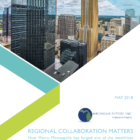Regional government is an elusive goal in many metropolitan areas. Look no further than metro Detroit, where several local suburban leaders are trying to kill a Regional Transit Authority that took decades to create.
But regional collaboration is on steroids in Minnesota’s Twin Cities, where a unique entity called the Metropolitan Council provides key services, including transit and wastewater treatment, for the seven-county metro area.
Another innovative regional program in metro Minneapolis, known as Fiscal Disparities, captures 40 percent of the annual increase in commercial, industrial and public utility tax bases in the region, and distributes it to nearly 200 taxing entities in the region.
The Met Council, as it’s known locally, and Fiscal Disparities are seen as national models of regional cooperation and key elements in making metro Minneapolis one of the most livable regions of the country.
Studies have shown that the Met Council has generally delivered services more efficiently and at a lower cost than local communities could do it on their own. And it has been a key driver in developing the metro area’s highly regarded public transit and regional park systems.
Fiscal Disparities is credited with reducing competition among local governments for development, helping less wealthy communities provide quality government services and allowing for better land-use planning.
“The program ensures that all residents enjoy a minimum standard of service for important local services, like public safety,” University of Minnesota professors Myron Orfield and Nicholas Wallace wrote in a 2007 study of Fiscal Disparities.
“By reducing the need for local governments to ‘steal’ revenue-generating land uses from each other, such policies allow them to engage in more thoughtful and beneficial land-use planning,” Orfield and Wallace wrote.
Regional planning agencies similar to the Met Council popped up across the country in the 1960s in response to the federal government’s requirement that planning be done on a regional basis in order to receive federal highway money.
But Minnesota political leaders decided to give the Met Council extraordinary powers in response to a critical need for better transit, improved wastewater treatment facilities and rapid growth that was gobbling up pristine natural areas many wanted to see preserved as parks and open space.
In 1967, Republican Gov. Harold LeVander signed legislation passed by the Republican-controlled Minnesota Legislature creating the Met Council.
In appointing the council’s first members, LeVander said the Met Council “was conceived with the idea that we will be faced with more and more problems that will pay no heed to the boundary lines which mark the end of one community in this metropolitan area and the beginning of another.”
The Met Council’s has 18 members, all appointed by the governor. None can be local elected government officials, an arrangement designed to head off parochial battles among local governments.
Over time, the Met Council took on responsibility for operating the regional sewer and transit systems, and administering federal low-income housing vouchers. It also has purchased tens of millions of dollars worth of parkland and open spaces for a regional park system, created in 1974, that now includes 53 parks and 340 miles of interconnected trails.
Fiscal Disparities grew out of concerns in the 1960s about widening disparities in local tax bases among various municipalities in the metro Minneapolis area.
A 1969 report by the Citizens League, entitled “Breaking the Tyranny of the Local Property Tax,” concluded that communities were paying widely different tax rates for a similar level of services. It also found that a growing number of communities with low tax bases were struggling to fund those services.
In response, the state Legislature in 1971 passed the Charles R. Weaver Metropolitan Revenue Distribution Act, named for a suburban Republican Minneapolis lawmaker who authored the law. It’s now known simply as Fiscal Disparities.
While Fiscal Disparities hasn’t eliminated the gap between communities with the highest and lowest commercial and industrial tax base, the program has greatly narrowed it.
In 2016, there was a 5-to-1 ratio between communities with the most and least commercial and industrial tax base per person. Without Fiscal Disparities, that ratio would have been 12 to 1, according to the Met Council.
“For the vast majority of (metro Minneapolis communities), the sharing program has meant lower taxes and better services,” Bruce Katz and Elizabeth Kneebone of the Brookings Institution wrote in 2015.
Orfield, who has extensively studied Fiscal Disparities, acknowledged that regional cooperation “is not an easy proposition. But if a region is faced with growing educational and economic disparity, there are two viable options: either allow the disparity to deepen, or work to find solutions that can benefit all.”
 Check our new report, Regional Collaboration Matters, How Metro Minneapolis has forged one of the wealthiest and most livable metropolitan regions in the United States, for more stories and lessons from the most successful state in the Great Lakes.
Check our new report, Regional Collaboration Matters, How Metro Minneapolis has forged one of the wealthiest and most livable metropolitan regions in the United States, for more stories and lessons from the most successful state in the Great Lakes.







